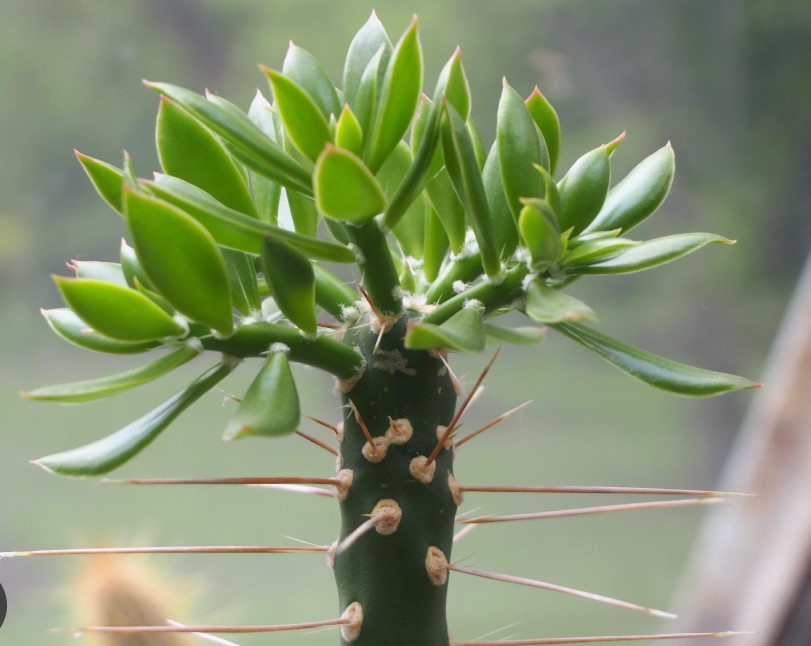Within the genus Quiabentia, there are two species: one found in Brazil and the other in Bolivia, Paraguay, and Argentina.
There was early and lingering confusion about the affinities of Quiabentia, however. Nathaniel Britton and Joseph Rose changed their minds regarding its classification during the writing of The Cactaceae. The leafy cacti have interested botanists because of their possible primitive features, suggesting what the first cacti may have looked like.
In 1919, they described Pereskia zehntneri. In 1923, however, they withdrew that species and substituted the description of the new genus Quiabentia with the single species, Q. zehntneri, the name of the genus based on the common name for the plant in Brazil, quiabento. The large, round, flattened seeds have a seed coat, and the fruits are elongated, meaty, and usually smooth.
Britton and Rose commented (1919–1923) that the large red flowers suggest Pereskia but that the fruits and seeds indicate a different genus, and since the older areoles also have glochids, the plant should “be referred to the Opuntieae and next to Pereskiopsis.” There are glochids, thorns, areoles, and leaves on the flower cup; the floral tube is absent.
The International Cactaceae Systematics Group changed its view of Quiabentia. At first, it was included in Pereskiopsis (Hunt and Taylor, 1986, 1990). Further analysis led to the conclusion that Quiabentia probably the South American counterpart of Pereskiopsis, a strictly Mexican genus. Whether Quiabentia and Pereskiopsis are truly the most closely related remains to be determined, but the group feels it best to recognize Quiabentia as a distinct genus with two species that flower during the day in summer. Subfamily Opuntioideae.
Plants are treelike or shrubby, with whorled, fleshy, round branches bearing flat, fleshy leaves. Leaves are broadly ovate to spatula-shaped and up to 7 cm (2.8 in) long. Areoles with glochids and numerous spines. Flowers borne sub-terminally or terminally, open during the day, rotate, showy, red, or pink; pericarpels with leaves, areoles, glochids, and spines; floral tubes absent. Fruits are oblong, fleshy, and usually smooth. Seeds are large, round, flattened, and have an aril. Distribution: one species in Brazil, another in Bolivia, Paraguay, and Argentina.

Quiabentia verticillata
It is an erect, woody succulent plant, growing tree-shaped or shrub-like.
-
Plants are treelike or shrubby, 2–15 meters (6.6–49 feet) high.
-
Habitat: Dry forests are infrequent in plain or mid-mountain habitats. It grows arbitrarily in vineyards and orchards when they aren’t irrigated, as well as in wastelands, roadside locations, and harsh sandy soils.
-
Leaves are oval to lance-shaped, 4-5 cm (1.6-2 in) long, and 2 cm (0.8 in) broad.
-
Spines are several, up to 7 cm (2.8 in) long.
-
The flowers are pale red and 1.5 cm (0.6 in) long.
-
Elevation: The plant grows at altitudes of 350 to 2000 meters.
-
Distribution: arid, lower regions of Bolivia, Paraguay, and northwestern Argentina.
-
Cultivation: Its laterally extensive, shallow root system allows it to flourish in locations with minimal rainfall, just like most other cacti. It is a xerophyte.
-
Taxonomy: Friedrich Karl Johann Vaupel gave Pereskia verticillata its first description in 1923.
-
Synonyms: Quiabentia verticillata (Vaupel) Borg (1937) and Grusonia verticillata (Vaupel) G.D. Rowley (2006).
Pereskia verticillata Vaupel (1923) Pereskia pflanzii Vaupel 1923, Quiabentia pflanzii (Vaupel) Vaupel 1925 Quiabentia chacoensis Backeberg 1935 Quiabentia pereziensis Backeberg 1956.
Quiabentia zehntneri
The specific epithet Zehntneri honors the Swiss biologist Leo Zehntner. The two authors created the new genus Quiabentia for the species in 1923 in the appendix to the fourth volume of their work, The Cactaceae.
Synonym: Britton & Rose, 1923 QUIABENTO Pereskia zehntneri Britton & Rose 1919. Grusonia Zehntneri (Britton & Rose) G.D. Rowley (2006) is another nomenclature synonym.
-
Plant shrubs up to 3 meters (9.8 feet) high.
-
The natural habitats of Quiabentia zehntneri, include subtropical or tropical dry forests and subtropical or tropical dry shrubland.
-
Family: it is a member of the Cactaceae family.
-
Stems are slender and green.
-
Leaves are ovate to almost round, pointed, and 2-4 cm (0.8–1.6 in) long.
-
Spines: There are many tiny white thorns all over the shoots.
-
Flowers are brilliant red, 3–4 cm (1.2–1.6 in) long and 7-8 cm (2.8–3.1 in) wide.
-
Altitude: About 450 to 750 meters.
-
Distribution: Bahia, Brazil
-
Taxonomy: In 1919, Nathaniel Lord Britton and Joseph Nelson Rose first described the species as Pereskia zehntneri.
Read More: Ferocactus cylindraceus (Engelmann) Orcutt 1926
